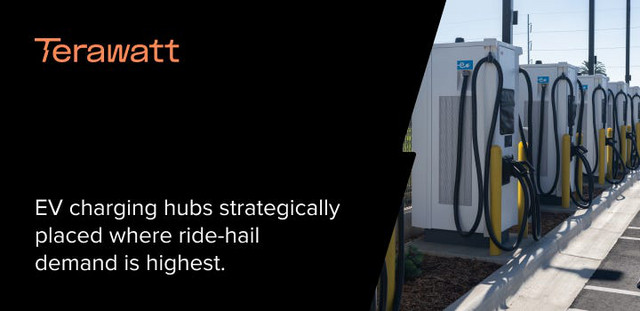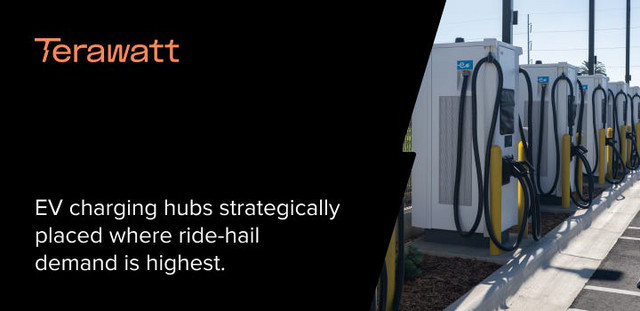Discover The Driverless Digest Podcast
The Driverless Digest Podcast

The Driverless Digest Podcast
Author: Harry Campbell
Subscribed: 4Played: 62Subscribe
Share
© Harry Campbell
Description
Covering the intersection of autonomy x rideshare, and the business of AVs.
www.thedriverlessdigest.com
www.thedriverlessdigest.com
24 Episodes
Reverse
Listen to this episode on Apple Podcasts, YouTube, Spotify, and Substack. We now have transcripts available too (Click on the “transcripts” button in the top right corner of this post to access them).In today’s episode, I’m speaking with Hansu Kim, longtime San Francisco political consultant with 20+ years of experience in transportation policy and legislation, and Chairman of Flywheel Technologies, one of Uber’s taxi fleet partners, and taxi booking platform. We get into how the Flywheel–Uber partnership actually works, what the customer experience looks like, and how the taxi industry is responding to this model.Hansu breaks down how Flywheel balances traditional taxi demand with Uber-induced trips, and how their approach boosts utilization while reducing congestion and emissions. We also talk about the benefits this model brings to drivers and TNCs, plus why taxi drivers still have a few meaningful advantages over regular rideshare drivers.We then shift into the AV world, from how Uber uses similar fleet-partnership frameworks to onboard autonomous vehicle companies, to how robotaxis in San Francisco are affecting demand. Hansu shares where taxis could fill important gaps for AV operators, his take on Waymo’s challenges, how driver income might change as AVs scale, and how Flywheel is preparing for that future, including their work with Nexar on next-gen AI cameras.Chapters(00:00) Introduction to Hansu Kim(01:25) Current state of the Flywheel-Uber partnership and the taxi industry(03:20) Mechanics of the partnership, and the customer experience(05:00) Is the Flywheel-Uber partnership model being embraced by the taxi industry?(08:32) Flywheel’s demand distribution — Traditional taxi demand vs Uber induced demand(09:21) How Flywheel maximizes vehicle utilization, and reduces congestion/pollution(10:13) Benefits of the Flywheel-Uber partnership model to drivers and TNCs(13:00) Flywheel’s business structure(19:58) Advantages of taxi drivers over regular rideshare drivers(23:30) How Uber uses the same fleet partnership model for autonomous vehicle companies(25:10) How AV companies benefit from TNC/taxi partnerships(26:15) Waymo’s challenges in SF, and how Flywheel could help (Disabled customers etc)(29:39) How have robotaxis in SF impacted taxi/rideshare demand?(32:20) How would taxi driver income change with the advent of AVs(34:18) Would AVs eventually compete with Taxis?(36:07) How Flywheel is preparing for the AV future(40:15) How Flywheel is partnering with Nexar for their new generation AI cameras(42:34) Hansu’s overall assessment of Waymo(45:12) Conclusion and final notesNotes/Links:* Hansu’s previous appearance on The Rideshare Guy podcast: Order An Uber Get A Taxi?! Uber X Taxis | RSG 207 (link).* RSG contributor Jay Cradeur tried out taxi driving with Flywheel: What’s It Like To Be A Taxi Driver vs an Uber Driver? (link).-HarryThanks for being a subscriber to The Driverless Digest! If you enjoyed this episode, feel free to share it with someone who might like it too. And if this email was forwarded to you, why not subscribe and stick around :) This is a public episode. If you would like to discuss this with other subscribers or get access to bonus episodes, visit www.thedriverlessdigest.com
Listen to this episode on Apple Podcasts, YouTube, Spotify, and Substack. We now have transcripts available too (Click on the “transcripts” button in the top right corner of this post to access them).In today’s episode, I’m speaking with Dawood Mian, a long time NYC fleet owner, and founder of AutoMarketplace, the largest content platform focused exclusively on New York city’s TLC market. We get into what makes the NYC TLC ecosystem unlike any other market in the country — from the regulatory framework and driver pay rules to the insurance realities. And why it’s such an important market for ridehail players like Uber and Waymo. Dawood breaks down how the market has evolved over the past years, the origin of lockouts, and how the economics of operating a rideshare fleet in New York differ dramatically from the rest of the U.S.Dawood also walks through the details of running a rideshare fleet in NYC: managing insurance costs, sourcing and maintaining vehicles, plate values, and the operational challenges for future AV fleets, like finding real estate for parking, staging, and maintenance.We also explore what it would take for a robotaxi operator like Waymo to launch in NYC — the regulatory steps, business barriers, and technical constraints that make New York one of the toughest markets for AV deployment. Dawood shares what he sees coming next for mobility in the city, and how both human-driven and future autonomous fleets may coexist in such a dense, tightly managed market.Chapters(00:00) Introduction to Dawood Mian(01:30) What makes the NYC TLC market unique(04:40) Why is insurance different for rideshare in NYC?(07:20) How the NYC rideshare/taxi market has evolved(09:50) NYC’s driver pay model, and the origin of lockouts(13:19) How the rideshare rental business works in NYC(16:30) Dawood’s fleet and business strategy(19:51) Insurance in NYC’s rideshare fleet business(22:57) Cost of an NYC TLC plate, and transferability(24:47) The mechanics of Waymo’s entry into the NYC ridehail market(30:00) Business and regulatory barriers to Waymo’s entry into New York city(36:35) The future of AVs in NYC(37:07) Are there technical/additional constraints to the operation of AVs in NYC?(39:50) Real estate challenges for fleet operators in NYC(43:55) Key NYC mobility issues to watch(46:26) Conclusion and final thoughtsNotes/Links:Check out Dawood’s website (AutoMarketplace), and you can follow his newsletter for the latest in NYC’s TLC market (link).- HarryThanks for being a subscriber to The Driverless Digest! If you enjoyed this episode, feel free to share it with someone who might like it too. And if this email was forwarded to you, why not subscribe and stick around :) This is a public episode. If you would like to discuss this with other subscribers or get access to bonus episodes, visit www.thedriverlessdigest.com
Listen to this episode on Apple Podcasts, YouTube, Spotify, and Substack. We now have transcripts available too (Click on the “transcripts” button in the top right corner of this post to access them).In today’s episode, I’m speaking with Dr. Xiaodi Hou, founder and CEO of Bot Auto, a company making big strides in autonomous trucking. Most recently, they completed their first human-less autonomous truck validation run — a major milestone in the push toward fully driver-out operations.We talk about Xiaodi’s journey before founding Bot Auto, how the autonomous vehicle landscape has evolved over the years, his perspective on whether autonomous driving has truly been “solved,” and the key milestones Bot Auto has hit on its road to commercialization. Xiaodi also dives into the cost savings from driver-out operations, and the unique economics of running a driverless fleet. We unpack how Bot Auto is able to achieve multiple operational milestones with relatively small capital and what it’ll take to boost revenue beyond their cost per mile.We also discuss the business side of autonomy — from Bot Auto’s model and approach to optimizing costs, to balancing cutting-edge technology with the realities of operations and customer acquisition. Xiaodi explains why Bot Auto doesn’t see itself as competing against human drivers, but rather solving the industry’s biggest pain points and creating value where it’s needed most.Chapters(00:00) Introduction to Dr. Xiaodi Hou(01:40) Background on Bot Auto(02:27) Xiaodi’s background and early ventures before Bot Auto(04:03) The early days of AV development vs now(06:15) Has autonomous driving been solved?(08:05) Key milestones in the commercialization of autonomous driving at Bot Auto(10:20) Cost savings from driver-out operations in autonomous trucking(13:50) Broad insights into the trucking industry (15:25) How autonomous trucks solve human/time factor limitations in trucking(17:10) Bot Auto’s business model(19:06) Optimizing the cost of autonomous trucking(24:40) Bot Auto’s human-less validation run, and its significance(28:35) How were you able to achieve multiple operational milestones with relatively small capital?(31:32) What would it take for Bot Auto to make money, and increase revenue over cost-per -mile?(32:53) How to balance the technology and business operations(34:33) Customer acquisition in autonomous trucking(35:55) Why does Bot Auto not compete against Humans? and their value proposition(37:45) How does highway driving compare to urban driving for autonomous trucks vs robotaxis?(41:25) Conclusion and final thoughtsNotes/Links:Bot Auto’s first human-less autonomous truck validation run* Full timelapse (link).* Article: Bot Auto Completes Human-Less Hub-To-Hub Validation Run In Texas (link, no paywall).- HarryThanks for being a subscriber to The Driverless Digest! If you enjoyed this episode, feel free to share it with someone who might like it too. And if this email was forwarded to you, why not subscribe and stick around :) This is a public episode. If you would like to discuss this with other subscribers or get access to bonus episodes, visit www.thedriverlessdigest.com
Listen to this episode on Apple Podcasts, YouTube, Spotify, and Substack. We now have transcripts available too (Click on the “transcripts” button in the top right corner of this post to access them).Join panelists at the just concluded Urban Autonomy Summit at Newlab in Brooklyn as they discuss how cities, fleets, and regulators can work together to ensure AVs are deployed safely and responsibly. The panel featured Zach Greenberger (CEO, Nexar), Sarah Kaufman (Commissioner, NYC TLC), Jeremy Moskowitz (EVP Rideshare, VGM), and Aparna Paladugu (VP Policy & Government Affairs, Via), moderated by Andrew Hawkins, Transportation Editor at The Verge.The conversation explores when robotaxis might realistically arrive in New York, how cities can balance safety and job security as AVs scale, and what kinds of data are most important in the AV deployment journey. The panelists also touch on policy pointers for the next NYC mayoral administration, the growing role of computer vision in rideshare and AV operations, and how partnerships between AV companies and public transit can support safer, more efficient streets.They dive into questions around liability, fleet management, and public trust, and discuss how equitable robotaxi distribution could shape the future of mobility in New York and beyond.Chapters(00:00) Introduction to panelists(00:44) When are robotaxis coming to New York?(03:08) How to bridge the gap between safety and job security in AV deployment(05:28) What kind of data is important in the AV deployment journey?(10:36) Pointers for the next NYC mayoral administration on AV deployment(13:38) Partnerships between AV companies and public transit(18:44) Importance of computer vision is AV deployment and rideshare(22:26) Questions around safety, fleet management, and liability as AVs begin to scale?(26:57) How to build public trust around robotaxi/rideshare data collection/sharing(33:25) How can robotaxis distribution be more equitable?(38:20) Conclusion and final thoughts- HarryThanks for being a subscriber to The Driverless Digest! If you enjoyed this episode, feel free to share it with someone who might like it too. And if this email was forwarded to you, why not subscribe and stick around :) This is a public episode. If you would like to discuss this with other subscribers or get access to bonus episodes, visit www.thedriverlessdigest.com
Listen to this episode on Apple Podcasts, YouTube, Spotify, and Substack. We now have transcripts available too (Click on the “transcripts” button in the top right corner of this post to access them).Join panelists, at the just concluded Urban Autonomy Summit at Newlab in Brooklyn as they dissect the impact the impact of AVs to existing fleets and driver earnings. The panel featured Ashwini Anburajan (CEO, Obi), Ryan Green (CEO, Gridwise), Daniel Muñoz (Co-Founder & COO, Tower Mobility), and Yariel Diaz (Director of Government Affairs, Serve Robotics), moderated by Natalie Lung, Tech Reporter at Bloomberg.The conversation explores how AVs are already affecting drivers’ earnings, how drivers and fleets are adapting, and where delivery bots fit into the mix. The panelists also touch on the kinds of new jobs AV deployment could create for humans — from fleet management to remote operations etc. They dive into AV ride pricing dynamics, the importance of pricing transparency for riders and drivers alike, and what the near future could look like for the gig economy.Chapters(00:00) Introduction to panelists(01:30) How AVs are affecting driver earnings(04:19) How are drivers adapting to AVs?(06:09) How has fleet management been affected by AVs?(08:34) The role of delivery robots in AV deployment(10:18) AV pricing dynamics for riders(14:23) Importance of rideshare pricing transparency(15:24) What jobs will AVs create for humans?(21:43) How is trust from drivers in existing fleets and AV partners maintained?(29:14) Data sharing between fleets and rideshare/AV companies(30:30) How do you improve utilization with additional AV deployment?(31:40) Mitigating adverse weather conditions for delivery robots- HarryThanks for being a subscriber to The Driverless Digest! If you enjoyed this episode, feel free to share it with someone who might like it too. And if this email was forwarded to you, why not subscribe and stick around :) This is a public episode. If you would like to discuss this with other subscribers or get access to bonus episodes, visit www.thedriverlessdigest.com
This week’s podcast is brought to you by Terawatt – purpose-built charging for autonomous vehicle fleets.Listen to this episode on Apple Podcasts, YouTube, Spotify, and Substack. We now have transcripts available too (Click on the “transcripts” button in the top right corner of this post to access them).In today’s episode, I’m speaking with David Zipper, a Senior Fellow at the MIT Mobility Initiative known for his writing on transportation policy, technology, and urban planning. He often writes about the impacts of autonomous vehicles (AVs) on cities, emphasizing concerns about increased congestion, safety risks from “car bloat”, and the potential for AVs to undermine public transit.We discuss the evolution of the ridehail industry and its broader impact on cities and mobility. David shares his perspective on the early days of autonomous vehicles, highlighting both their promise and the risks they pose — particularly around congestion and the potential to draw riders away from public transit.He breaks down why cheaper AV rides could worsen traffic, the role that policy tools like bus rapid transit, congestion pricing, and deadheading fees could play in addressing it, and whether robotaxis can meaningfully improve road safety. We also touch on the shared responsibilities of governments and AV companies, potential synergies between AVs and transit, and how cities can better design pickup and drop-off zones to serve riders, cyclists, and pedestrians alike.Chapters(00:00) Introduction to David Zipper(02:29) David’s new transportation podcast(03:39) Overall view of the ridehail industry and its impact on society(07:30) How do you feel about AVs at this early stage?(09:34) The biggest potential negative impact of AVs (Congestion)(11:45) Should ridehail be blamed for congestion in cities?(15:20) How price reduction in AVs could potentially affect congestion(17:14) What are the solutions to congestion in the advent of AVs?(24:11) Can robotaxis reduce road fatalities?(30:40) The role of Government and AV companies in road safety(31:01) AVs vs Public Transit(34:24) Possible synergies between AVs and Transit(37:13) Improving pickup and drop-off points for ridehail/AVs(39:30) Cyclists and Pedestrians in the Age of AVs(43:00) Conclusion and final thoughtsNotes/Links:* Check out David’s website (link) to join his newsletter and explore his past writing.* David’s new podcast: Look Both Ways with David & Wes (link).* David’s Vox Article: A self-driving car traffic jam is coming for US cities (link).Designing Charging Hubs for Autonomous FleetsWe are excited to partner with Terawatt, one of the leading providers of charging infrastructure. To learn more about Terawatt’s network of AV charging hubs and track record of 99%+ uptime, reach out to Logan Szidik at lszidik@terawattinfrastructure.com- Harry This is a public episode. If you would like to discuss this with other subscribers or get access to bonus episodes, visit www.thedriverlessdigest.com
It’s less than two days until our first annual Urban Autonomy Summit, presented by Nexar, on October 8th, at Newlab in Brooklyn. We’re down to just a few spots, so this is your last chance to apply and make sure you don’t miss out on the action. Register here to secure your spot!Listen to this episode on Apple Podcasts, YouTube, Spotify, and Substack. We now have transcripts available too (Click on the “transcripts” button in the top right corner of this post to access them).In today’s episode, I’m speaking with Dimitri Strobbe, Director of Road Maintenance at the Brussels Capital Region, who recently joined a study tour in China, testing autonomous vehicles from major local players and engaging with industry leaders to see firsthand how the technology is developing abroad. We discussed the study tour and the impetus behind it, as well as his interactions with Chinese autonomous vehicle companies and executives. He also talked about his experience testing various AV products from companies like Pony.ai, Baidu, Xpeng, and Huawei, and how these experiences measured up to his expectations.Dimitri dove into some of the things that stood out in Chinese society, including urban infrastructure and technological shocks he experienced during the study tour, as well as his interactions with Chinese AVs and society. He discussed the differences in transparency between Chinese AV companies and American ones like Waymo, and wrapped up with some lessons learned from the trip.Chapters(00:00) Introduction to Dimitri Strobbe(02:02) Details of the China study tour(03:35) The impetus for the China Study Tour(06:55) How transparent were Chinese AV companies?(7:57) Which AV companies did you interact with in China?(08:42) What was the experience riding Chinese robotaxis and Robobuses?(11:25) What stood out with the robotaxis(14:19) Expectations vs reality(17:35) High-level AV executive interactions in China(20:35) What stood out with the Chinese society(23:16) Urban infrastructure shocks(24:28) Automation of AV maintenance/charging in China(25:26) DiDi’s giant AV strides(26:39) Take-home lessons from the China study tour(32:20) Conclusion and final thoughtsNotes/Links:* Apply to attend our Urban Autonomy Summit here* Itinerary for the China study tour (link).* Dimitri’s first/second post about the China Study Tour.* Jacco’s post on Neolix’s autonomous cargo delivery robots from the Study Tour (he was another participant).* Pieter’s video of Chinese AVs demonstrating autonomous maintenance and charging (he was another participant of the Study Tour)- HarryThanks for being a subscriber to The Driverless Digest! If you enjoyed this episode, feel free to share it with someone who might like it too. And if this email was forwarded to you, why not subscribe and stick around :) This is a public episode. If you would like to discuss this with other subscribers or get access to bonus episodes, visit www.thedriverlessdigest.com
It’s less than a month until our first annual Urban Autonomy Summit, presented by Nexar, on October 8th, at Newlab in Brooklyn. Space is limited, but you can apply to attend here if you’re interested in joining the festivities!Listen to this episode on Apple Podcasts, YouTube, Spotify, and Substack. We now have transcripts available too (Click on the “transcripts” button in the top right corner of this post to access them).In today’s episode, I’m speaking with Ashwini Anburajan, CEO of Obi, an app that compares real-time prices and pickup times across ride-hailing platforms. We discuss Ashwini’s journey from Upside to Obi, and her recent rise to the role of CEO. She goes over the facts and figures on price differences among human/AV rideshare providers and the recent trends in rideshare pricing, including rideshare loyalty programs and opportunities for riders and providers. She also talks about Obi’s international operations and their somewhat complicated relationship with rideshare providers.Ashwini dove into Waymo’s recent pricing data and shared additional insights, including customer attitude toward wait times and her thoughts on Waymo’s pricing model across its jurisdictions — such as Waymo on Uber in Austin and the forthcoming Waymo on Lyft in Nashville. We also discussed how the AV landscape would evolve in the coming times, and market fragmentation from the customers’ POV.Chapters(00:00) Introduction to Ashwini, and her background(03:34) What Obi does and Ashwini’s focus as the new CEO(05:14) Insights on pricing differences among human/AV rideshare providers and the logic behind them(09:54) Recent trends in rideshare pricing(11:49) Rideshare customer pricing behaviour(14:16) Rideshare loyalty programs and the opportunities that lie within(16:18) The international landscape of rideshare(20:23) Obi’s international operations(21:29) Obi’s relationship with rideshare providers(22:59) Waymo pricing report(25:59) Customer attitude towards wait times(28:49) Ashwini’s thoughts on Waymo’s pricing(31:19) Peculiarities of Waymo on Uber, in Austin and Atlanta(32:18) Lyft–Waymo partnership and pricing insights(35:12) How will the AV landscape evolve from the customer/pricing POV?(36:46) Human/AV rideshare market fragmentation from the customers’ POV(38:50) Conclusion and final thoughtsNotes/Links:* Apply to attend our Urban Autonomy Summit here* Obi’s Waymo pricing data - The Road Ahead: Pricing Insights On Waymo, Uber and Lyft* TechCrunch article on Obi’s Waymo pricing data - Waymo rides cost more than Uber or Lyft — and people are paying anyway* Forbes article highlighting Obi’s Waymo pricing data - Waymo Is A Trillion-Dollar Opportunity. Google Just Needs To Seize It (no paywall)* Obi blog (link)- HarryThanks for being a subscriber to The Driverless Digest! If you enjoyed this episode, feel free to share it with someone who might like it too. And if this email was forwarded to you, why not subscribe and stick around :) This is a public episode. If you would like to discuss this with other subscribers or get access to bonus episodes, visit www.thedriverlessdigest.com
This week’s podcast is brought to you by Terawatt – purpose-built charging for autonomous vehicle fleets.Listen to this episode on Apple Podcasts, YouTube, Spotify, and Substack. We now have transcripts available too (Click on the "transcripts" button in the top right corner of this post to access them).In today’s episode, I’m speaking with Daniel and Andres Munoz, co-founders of Tower Mobility. They are one of Uber’s largest fleet partners and operate with a unique W2 driver model, where all of their drivers are employees and they own every vehicle in the fleet. This model allows them to invest in training for their drivers, infrastructure for their vehicles, charging and more. We also go into the details of their Uber partnership, especially from the insurance and safety perspectives.We also discuss the main challenges of managing a human fleet and how this might evolve with the advent of AV fleets, touching on charging infrastructure and Tower’s future plans as AVs take more market share. If you enjoyed this episode and would like to hear more about Tower, they will be one of our featured speakers at the Urban Autonomy Summit in NYC on 10/8. Space is limited, but you can apply to attend here if you’re interested in joining the festivities!Chapters(0:00) Introduction to Daniel and Andres(02:53) Background on Tower Mobility and how it started(04:40) The difference between W2 drivers and independent contractors(06:50) What types of drivers does Tower Mobility recruit and how do they find them?(10:15) Tower Mobility driver benefits/comp(13:27) Tower Mobility’s partnership with Uber and its benefits(19:50) Insurance and Safety benefits of Towers model(23:15) The main challenges of managing a human/autonomous vehicle fleet(26:38) Tower’s fleet size and details(27:58) What benefits come with managing an EV fleet?(32:23) How Tower handles charging for their EV fleet(34:18) Tower’s future plans in the advent of AVs, and business with Waymo(39:25) Conclusion and final thoughtsDesigning Charging Hubs for Autonomous FleetsWe are excited to partner with Terawatt, one of the leading providers of charging infrastructure. To learn more about Terawatt's network of AV charging hubs and track record of 99%+ uptime, reach out to Logan Szidik at lszidik@terawattinfrastructure.com- Harry This is a public episode. If you would like to discuss this with other subscribers or get access to bonus episodes, visit www.thedriverlessdigest.com
This week’s podcast is brought to you by Terawatt – purpose-built charging for autonomous vehicle fleets.Listen to this episode on Apple Podcasts, YouTube, Spotify, and Substack. We now have transcripts available too (Click on the "transcripts" button in the top right corner of this post to access them).In today’s episode, I’m speaking with James Cox, Ex Uber Pool Exec, and CEO at The Routing Company, a startup that’s transforming transit with routing and optimization software. James talks about his time at Uber Pool and how ridepooling worked, and the lessons learned there that could be applied to AVs. He also talks about The Routing Company and how their technology has been applied in real world deployments.We also discuss The Routing Company’s recent technology license agreement to Zoox, and the key to making AV ridepooling work. Finally, we dive into the potential challenges of ridepooling for AVs, the overlap of AV ridepooling against public transit, the importance of vehicle form factor in ridepooling, and the public sentiment towards shared rides. Chapters(00:00) Who is James Cox and what is his background?(02:20) James’ background at Uber Pool(05:04) Uber’s dynamic pricing with varying demand(06:23) The mechanics of ridepooling in the Uberpool product(10:42) Background on The Routing Company(11:57) The Routing Company’s technology in action(13:35) The keys to making ride pooling work(18:00) Lessons for AVs from human ridepooling(20:10) Ridepooling pick-up and drop-off challenges for AVs(21:15) How Uber pool increased traffic in certain markets, and how this applies to AVs(23:00) Making a case for AV ridepooling(24:57) The Routing Company’s technology license agreement to Zoox(26:44) What you need to be successful in the AV ridepooling space(27:37) When is the right time for AV companies to go into ridepooling?(30:25) How does ridepooling solve high ETAs(33:40) Do riders in the U.S. want to share rides?(36:08) AV ridepooling vs public transit(38:31) Does vehicle form factor matter in ridepooling?(40:57) Conclusion and final thoughtsDesigning Charging Hubs for Autonomous FleetsWe are excited to partner with Terawatt, one of the leading providers of charging infrastructure. To learn more about Terawatt's network of AV charging hubs and track record of 99%+ uptime, reach out to Logan Szidik at lszidik@terawattinfrastructure.com- Harry This is a public episode. If you would like to discuss this with other subscribers or get access to bonus episodes, visit www.thedriverlessdigest.com
This week’s podcast is brought to you by Terawatt – purpose-built charging for autonomous vehicle fleets.Listen to this episode on Apple Podcasts, YouTube, Spotify, and Substack. We now have transcripts available too (Click on the "transcripts" button in the top right corner of this post to access them).In today’s episode, I’m speaking with Edwin Olson, founder and CEO of May Mobility, an autonomous vehicle company that just launched their AV pilot program in Atlanta, in collaboration with Lyft. Ed talks about May Mobility’s business strategy, their vehicle specs and what makes them stand out. We also get into why now is the most exciting time for AVs, and the commercialization challenges faced by AV companies.Ed weighs in on the camera vs. Lidar debate, the cost and integration of their hardware stack, and how May Mobility approaches scaling and vehicle production. We also dive into their pilot launch with Lyft in Atlanta — from backend integration to the first-time rider experience — why riders have chosen to pay more for AV rides in the past, and the key metrics that define customer experience. He explains the company’s collaboration with Toyota, partnerships with platforms like Lyft and Uber, and the emphasis on scaling both technologically and commercially.Chapters(00:00) Introduction to Ed Olson(02:05) Is now the most exciting time for Autonomous Vehicles?(03:25) The commercialization challenge of AVs(03:57) Introduction to May Mobility, and what makes them stand out(05:33) May Mobility’s business strategy(06:39) May Mobility’s vehicle and specs(08:20) Vehicle hardware and technology stack(09:04) Ed’s take on the Camera vs Lidar debate(10:17) The cost of May Mobility’s hardware stack(12:09) May Mobility’s vehicle production process, and hardware integration(14:42) The path to scaling(16:50) May Mobility’s partnership with Lyft in Atlanta(18:12) The optimum fleet size for efficient utilization and ride availability(20:02) Advantages of an AV ride and why passengers choose to pay more(22:05) How the May Mobility–Lyft partnership user experience will work for passengers(23:15) What is an ideal ride for May Mobility?(25:00) The backend of the Lyft partnership(25:40) The first time experience for AV rideshare(27:44) The main KPI in AV customer experience(29:54) What makes May Mobility stand out.(32:10) The downsides of AV third party partnerships(33:25) How to solve vehicle availability in high demand(34:29) How the future of autonomy looks like(38:29) Conclusion and final thoughtsDesigning Charging Hubs for Autonomous FleetsWe are excited to partner with Terawatt, one of the leading providers of charging infrastructure. To learn more about Terawatt's network of AV charging hubs and track record of 99%+ uptime, reach out to Logan Szidik at lszidik@terawattinfrastructure.com- Harry This is a public episode. If you would like to discuss this with other subscribers or get access to bonus episodes, visit www.thedriverlessdigest.com
Listen to this episode on Apple Podcasts, YouTube, Spotify, and Substack.In today’s episode, I’m speaking with Neha Palmer, CEO and Co-founder of Terawatt, one of the leading providers of charging infrastructure for AV/EV fleets. Neha talks about her journey in the energy industry, highlighting her background leading global energy strategy at Google. She explains Terawatt’s focus on providing AV/EV charging solutions and the motivation behind her founding the company.We discuss the unique process and intricacies of building and launching charging sites suitable for AV/EV fleets of varying sizes, and the technical/logistical requirements of these sites. We also touch on how Terawatt uses their data to work with fleet owners to ensure they get the best utilization for their vehicles while maintaining access to charging sites with excellent uptimes.We also discuss their biggest challenges with customers, charging requirements for fleets and other services offered at their charging sites.Chapters(00:00) Introduction to Neha Palmer(01:33) Neha’s background at Google(02:31) Introduction to Terawatt, and how they help AV/EV fleets(04:55) The challenges of providing AV/EV fleet charging solutions(05:53) The impetus behind behind Neha founding Terawatt(06:57) The benefits of renewable energy for fleets(08:48) What industries does Terawatt focus on? and their footprint(10:10) How Terawatt got their first AV customer(11:31) What it takes to build and launch a charging site(12:35) How many sites does Terawatt have currently(14:03) The optimal locations for building charging sites(17:05) Hardware/power requirements for charging sites and how they evolve(19:40) How fast do vehicles charge at Terawatt’s charging sites(21:22) How Terawatt works with partners to design operating domains, and the data involved(23:28) How time of use works for AV/EV fleet charging(26:16) The EV to AV transitions, and how it has affected Terawatt’s business(28:20) Quantitative charging requirements for fleets(30:10) Biggest challenges experienced with new customers(32:00) What other services does Terawatt offer at their charging sites(33:30) Fully autonomous charging(35:30) Conclusion and Final ThoughtsNotes/Links:* Link to Neha’s previous webinar appearance on Ride AI - Ride AI x Terawatt Webinar 7/1/25- HarryThanks for being a subscriber to The Driverless Digest! If you enjoyed this episode, feel free to share it with someone who might like it too. And if this email was forwarded to you, why not subscribe and stick around :) This is a public episode. If you would like to discuss this with other subscribers or get access to bonus episodes, visit www.thedriverlessdigest.com
This week’s podcast is brought to you by Terawatt – purpose-built charging for autonomous vehicle fleets.Listen to this episode on Apple Podcasts, YouTube, Spotify, and Substack.In today’s episode, I’m speaking with Chris Paxton, author of It Can Think!, and a roboticist who's worked all across the industry (Zoox, Nvidia, Meta etc). He’s currently leading AI innovation at Agility Robotics, developing intelligent and useful humanoid robots.Chris talks about his career journey, provides an insightful analysis of Waymo's autonomous vehicle advancements, comparing them with Tesla's approach, and gives a full break down of the cost components of Waymo's Zeekr vehicle.Our discussion also touches on industry challenges, such as hardware sourcing, sensor integration, and compute requirements, providing a comprehensive understanding of the current state and future directions of robotics and autonomous vehicles.Chapters(00:00) Introduction to Chris Paxton(01:58) What got Chris interested in robotics(02:50) The inspiration behind Chris Paxton’s post about the Waymo Zeekr(04:59) Details on the Waymo Zeekr – Cost, specs, assembly etc(09:27) Chinese EV tariffs vs. the Waymo Zeekr(12:03) Sensor costs and how they affect AV production(13:20) What compute means and the chips behind our robotaxis(14:59) How compute works in making autonomy a reality(16:15) How is all of the gathered data integrated into the generalized driver?(17:20) What is integration cost in robotaxi production?(20:30) What areas of robotaxi production have the most room for cost reduction?(22:28) How Waymo’s Zeekr robotaxis stack against their Jaguar I-PACE robotaxis(25:18) How the costs of AV parts have changed over the years(26:26) Thoughts on Tesla’s camera-only approach vs Lidar(28:31) Downsides to having too much Hardware(30:37) The highway operation challenge(31:36) Waymo vs Tesla’s approach(34:35) Insights on other AV companies(36:09) Differences between the AV 1.0 and AV 2.0 approach(39:49) Conclusion and Final ThoughtsNotes/LinksLink to Chris Paxton’s post about the Waymo Zeekr mentioned at (04:28) - The First Mass-Produced Robotaxi Is HereDesigning Charging Hubs for Autonomous FleetsWe are excited to partner with Terawatt, one of the leading providers of charging infrastructure. To learn more about Terawatt's network of AV charging hubs and track record of 99%+ uptime, reach out to Logan Szidik at lszidik@terawattinfrastructure.com- Harry This is a public episode. If you would like to discuss this with other subscribers or get access to bonus episodes, visit www.thedriverlessdigest.com
Listen to this episode on Apple Podcasts, YouTube, Spotify, and Substack.In today’s episode, I’m speaking with Ross Gerber, co-founder and CEO of Gerber Kawasaki, a Los Angeles-based investment firm managing over $1.5 billion in assets. Ross, a longtime Tesla investor and frequent media guest on outlets like CNBC, shares his insights into the future of mobility, focusing on electric vehicles (EVs), ridehailing services, and autonomous vehicles (AVs).He talks about his investment interests, and some lessons from the early days of ridesharing. Ross also discusses the current ridesharing TAM and the position of autonomous vehicle providers like Waymo in the current market.We touch on the Tesla robotaxi rollout and his thoughts on their vision only approach, against the multiple sensor approach of other players, and Uber’s position in a fragmented AV market.Chapters(00:00) Introduction to Ross Gerber(01:15) Ross’ investment interests, and the future of mobility.(03:25) Background on Gerber Kawasaki(05:12) Lessons from the early days of ridesharing(09:27) Thoughts on the intersection of rideshare and autonomy(12:37) Why a 100% robotaxi world is not feasible(15:00) Waymo vs Uber(18:35) What it’d take for Waymo to surpass Uber and Lyft’s market share(21:56) Robotaxi limitations for older riders(23:27) What is the investment potential in Waymo? And advertising opportunities(27:43) Thoughts on Tesla’s robotaxi rollout(33:00) Camera only vs multiple sensor approach(34:10) Who benefits most from a fragmented AV market?(35:08) How solid Uber’s AV platform approach is(39:25) Ross’ insights on the current ridesharing Total Addressable Market (TAM)(41:36) Conclusion and Final Thoughts- HarryThanks for being a subscriber to The Driverless Digest! If you enjoyed this episode, feel free to share it with someone who might like it too. And if this email was forwarded to you, why not subscribe and stick around :)You can also support us through these means:* Sponsor The Driverless Digest, the newsletter that covers the intersection of rideshare and autonomy, and the business of AVs. Read by 2,000+ engaged readers, including AV enthusiasts, executives, and industry professionals* We have packages that include podcast appearances, job listings and more!* Send us ideas or tips: Got a story idea, suggestion, or something we should dig into? We’re all ears.Reply or reach out to Harry@therideshareguy.com to learn more This is a public episode. If you would like to discuss this with other subscribers or get access to bonus episodes, visit www.thedriverlessdigest.com
Listen to this episode on Apple Podcasts, YouTube, Spotify, and Substack.In today’s episode, I’m speaking with Andrew Chapin, Chief Operating Officer at Nuro, a leading self-driving technology company. Andrew was also among the earliest employees at Uber, rising to lead their global vehicle programs and partnerships, so it was cool to hear about this partnership coming full circle for him.We discuss Nuro’s history and recent pivot from purpose built delivery vehicles into licensing their autonomous technology for robotaxis and personally owned autonomous vehicles. We also spent a lot of time covering their recent partnership with Uber and Lucid to equip 20,000 Lucid Gravity’s with the Nuro driver, for deployment on the Uber network.We also dive into the differences between the AV 1.0 and AV 2.0 models, Nuro's AI-first approach, the complexities of integrating self-driving technologies into vehicles, and the future of autonomy in both ride-share and delivery servicesChapters(00:00) Introduction to Andrew Chapin and Nuro(02:13) Overview of Nuro and how their focus has changed over the years(05:05) The difference between AV 1.0 vs AV 2.0(07:18) Challenges in developing and deploying AVs(08:48) The main advantage of the Nuro–Lucid–Uber partnership.(09:36) Details of the current Nuro product — The Nuro Driver(10:35) What the Nuro-Lucid robotaxi would look like(12:24) How the Nuro Driver will complement the Lucid Gravity(14:20) Cost of Integrating the Nuro Hardware and the Scalability of their approach(17:57) Nuro’s past products and driverless deployments(24:01) Behind the Scenes of the Nuro–Lucid–Uber Partnership(26:27) Why did Uber choose Nuro(28:12) The Nuro Driver’s safety case(31:42) Uber’s role in the Nuro–Lucid–Uber Partnership(34:54) Nuro’s vision for the future of autonomy(36:30) The most popular and possible use cases for autonomy(42:10) Conclusion and final thoughts- HarryThanks for being a subscriber to The Driverless Digest! If you enjoyed this episode, feel free to share it with someone who might like it too. And if this email was forwarded to you, why not subscribe and stick around :)You can also support us through these means:* Sponsor The Driverless Digest, the newsletter that covers the intersection of rideshare and autonomy, and the business of AVs. Read by 2,000+ engaged readers, including AV enthusiasts, executives, and industry professionals* We have packages that include podcast appearances, job listings and more!* Send us ideas or tips: Got a story idea, suggestion, or something we should dig into? We’re all ears.Reply or reach out to Harry@therideshareguy.com to learn more! This is a public episode. If you would like to discuss this with other subscribers or get access to bonus episodes, visit www.thedriverlessdigest.com
Listen to this episode on Apple Podcasts, YouTube, Spotify, and Substack.In today's episode, I’m speaking with Brad Hargreaves, editor of Thesis Driven, a top Substack publication covering innovation in the built world. He is also the co-founder of General Assembly and Common, a multifamily operating company focused on innovative housing typologies like co-living.Brad lays out an eloquent case for the upcoming transformations in real estate driven by autonomous vehicles (AVs). We discuss the anticipated decline of gas stations and urban parking garages, the rise of exurban living as AVs make commutes less painful, and the potential redesigns of AV interiors for enhanced commuting experiences.We also dive into the impact of elevated interest rates on real estate investment, the growing demand for industrial properties and data centers, and the importance of city regulations in accommodating AVs. Brad shares his insights on the broader implications of these trends and suggests investment strategies for the future.Chapters(00:00) Introduction to Brad Hargreaves(01:19) What is Thesis Driven? And the motivation behind it(03:55) The current state of the real estate market in 2025(06:50) Why now is the right time for real estate investors to pay attention to AVs(09:30) The role of geography in real estate investors’ perception of AVs(11:00) Where would autonomous vehicles have the most impact in real estate?(13:17) What are the options for real estate investors in the era of AVs?(15:15) Future assumptions about AVs and their potential impact on real estate(18:03) Public space and safety concerns with AVs(20:47) How AVs could change where people choose to live, and its role in suburbanization(24:54) The cost of AVs and how it compares to traditional rideshare(27:40) Current trends in real estate and commute(29:42) How AVs could evolve ergonomically to favor long commutes(31:30) How AVs could change the concept of weekend trips(33:52) Some real estate investment opportunities in the era of AVs(37:00) Surprising real estate outcomes that could arise from AV adoption(40:00) Conclusion and final thoughtsNotes/Links:* Link to Brad’s article and tweet mentioned at (6:54) - Autonomous Vehicles Are Finally Here. Now What? - Tweet- HarryThanks for being a subscriber to The Driverless Digest! If you enjoyed this episode, feel free to share it with someone who might like it too. And if this email was forwarded to you, why not subscribe and stick around :)You can also support us by:* Sponsoring The Driverless Digest, the newsletter that covers the intersection of rideshare and autonomy, and the business of AVs. Read by 2,000+ engaged readers, including AV enthusiasts, executives, and industry professionals* Send us ideas or tips: Got a story idea, suggestion, or something we should dig into? We’re all ears.Reply or reach out to Harry@therideshareguy.com to learn more! This is a public episode. If you would like to discuss this with other subscribers or get access to bonus episodes, visit www.thedriverlessdigest.com
Listen to this episode on Apple Podcasts, YouTube, Spotify, and Substack.In today's episode, I’m speaking with Alex Kendall, co-founder and CEO of Wayve, a leading AI company in the autonomous driving space. Founded in 2017, Wayve focuses on creating a general-purpose driving intelligence through an end-to-end AI model that can drive any vehicle anywhere without relying on pre-mapping. Alex talks about his journey from award-winning research at Cambridge to pioneering Wayve’s innovative technology, the global reach of their autonomous fleet over the past three months, and partnerships with major OEMs and Uber.We also go into the scalability of their software, the integration with different hardware and sensor architectures, and the diverse applications in both consumer and shared fleet markets. Alex emphasizes the technology’s ability to handle complex driving scenarios and shares his vision for the future of autonomous mobility.Chapters(00:00) Introduction to Alex Kendall and Wayve(01:17) Alex’s/Wayve’s accomplishments and milestones so far(02:29) How does Wayve's AI work?(03:35) Why they chose the end-to-end AI driver model(05:05) Alex’s thoughts on the current AV landscape(06:52) Hardware on the Wayve AVs(08:20) What takes priority, hardware or maps?(09:50) Insights into the future of AV hardware(13:06) Importance of user data in AV deployment(14:08) Wayve’s vs Tesla’s approach(15:37) How is the Wayve end-to-end AI model more scalable than others?(17:30) Wayve’s software compatibility with OEM vehicle hardware(23:11) Insights on Wayve’s partnership with Uber(28:29) Personally owned autonomous vehicles vs shared fleet (rideshare)(30:34) Conclusion and Final Thoughts- Harry This is a public episode. If you would like to discuss this with other subscribers or get access to bonus episodes, visit www.thedriverlessdigest.com
Listen to this episode on Apple Podcasts, YouTube, Spotify, and Substack.In today’s episode, I am speaking with Helen K. Pan, General Manager of Apollo Autonomous Driving USA, Baidu's Self-Driving Division. We talk about Helen’s journey since joining Baidu's Intelligent Driving Group in 2017, and get an inside look at Apollo Go, Baidu’s autonomous ride-hailing service. She discusses the technology, safety measures, and cost efficiency of Apollo Go's latest generation vehicle, the RT6, which operates in multiple cities globally and costs just $30,000.We also discuss the dynamics of the Chinese AV market, the company’s global expansion plans, and the unique passenger-centric design of Apollo Go's fleet. We also got into regulatory challenges, market potential, the tech behind their robotaxis, and their current partnership and collaboration efforts.Chapters(00:00) Introduction to Helen K. Pan(01:47) Background on Baidu and Apollo Go(03:35) Apollo Go operational cities, fleet size and achievements(08:07) Current landscape of the Chinese autonomous vehicle market(09:50) Robotaxi market growth potential in China vs. USA(11:30) Apollo Go ride concentration in operational domains, and comparisons(14:10) How is the user experience and public reception in China?(18:45) Apollo Go safety and insurance data(19:57) Apollo Go superior passenger experience and passenger-centric design(23:48) Insights on Apollo Go robotaxis’ passenger-centric design and cost efficiency.(26:27) Manufacturing and development timelines for Apollo robotaxis(28:16) Apollo robotaxi sensor stack and future price outlook(30:38) Global expansion plans and market opportunities(34:14) US expansion plans(35:37) Innovations with partners and future collaboration(37:09) Main challenges faced by Apollo Go(39:57) Conclusion and Final ThoughtsNotes/Links:* Link to Sophia Tung’s robotaxi video mentioned at (22:01) - I was wrong about Chinese robotaxis... (24h riding ONLY Apollo Go)- Harry This is a public episode. If you would like to discuss this with other subscribers or get access to bonus episodes, visit www.thedriverlessdigest.com
Listen to this episode on Apple Podcasts, YouTube, Spotify, and Substack.In this episode, I chat with Jon McNeill, a veteran entrepreneur, investor, and industry executive. Prior to his current CEO and co-founder role at DVx Ventures, Jon was President at Tesla and COO at Lyft. We talk about Jon's background, the recent Tesla robotaxi launch, and Tesla’s approach to autonomy, especially compared to other top players like Waymo.We also discuss the potential market shifts due to autonomous vehicles (AVs) and the impacts on Uber and Lyft. Jon shares insights on hardware and software developments, market sizes, media misunderstandings about Tesla, and future trends in the AV space. We close the conversation with a discussion on investment opportunities in the AV sector and Jon’s role at DVX Ventures.Chapters(00:00) Introduction to Jon McNeill(01:30) First impressions and thoughts on the Tesla robotaxi rollout(02:50) Jon’s experience at Tesla, and how it might play into autonomy(05:00) Thoughts on the media coverage and market perception of Tesla(07:28) How does Tesla compare to Waymo’s hardware and software?(13:34) Thoughts on robotaxi scalability and market impact for Tesla vs Waymo(17:35) What do you think of Uber and Lyft’s position in the AV space?(19:43) Waymo's impact on rideshare in San Francisco?(20:17) Consumer comfort in autonomous vehicles(20:47) Uber and Lyft’s strategic moves to stay in the game(21:08) Rideshare demand and supply dynamics with autonomous vehicles(22:37) Future market predictions for Uber and Lyft(23:09) Does Waymo need Uber more than Uber needs Waymo?(28:04) How Does Waymo solve the utilization problem without Uber(29:57) How autonomy fits into DVx Ventures business(33:30) Current untapped opportunities in the AV/Autonomy space for entrepreneurs and Founders(35:19) Conclusion and Final ThoughtsNotes/Links:* RSG093: Why Lyft COO Jon McNeill is All About The Drivers! (link).- Harry This is a public episode. If you would like to discuss this with other subscribers or get access to bonus episodes, visit www.thedriverlessdigest.com
Listen to this episode on Apple Podcasts, YouTube, Spotify, and Substack.In this episode, I chat with Professor Philip Koopman, a top voice in Autonomous Vehicle safety with nearly 30 years of experience in the field, and a longtime professor and researcher at Carnegie Mellon University. We talk about his transition out of academia, what originally motivated his writing on AV safety, and how the industry’s been responding (or not responding) to the standards he’s been advocating for.Phil shares his take on Waymo’s safety record, Tesla’s robotaxi launch, and why measuring AV safety isn’t as simple as counting injuries and crashes. We also get into how public trust is built—or lost—and what AV companies need to be thinking about as they move from pilot to scale.Just a note: we recorded this episode on 6/17 before Tesla’s robotaxi launch but focused 90% of the conversation on more broad AV themes and evergreen topics.Chapters(00:00) Introduction to Professor Philip Koopman(01:31) Phil's transition from academia to consulting?(02:14) What was the motivation behind Phil's writing on AV safety?(05:20) Phil’s general outlook on the AV industry and companies.(10:22) Thoughts on Waymo's safety record and industry challenges?(17:50) How do freeways impact AV safety?(21:24) What are the objective measures for AV safety?(23:18) Some AV industry safety standards?(24:46) What’s the flaw in counting injuries and fatalities in AV safety reporting?(26:44) Real world examples of safety incidents beyond injuries and fatalities(28:53) Legal implications of negligence(31:55) Public perception and trust in AV technology, and how they’re shaped(35:18) AV Companies’ outlook on public perception.(39:14) What are your thoughts on Tesla’s Robotaxi deployment?(47:10) Final thoughts and advice for AV companiesPhil Koopman’s Substack: Autonomous System Safety by Phil Koopman- Harry This is a public episode. If you would like to discuss this with other subscribers or get access to bonus episodes, visit www.thedriverlessdigest.com
























